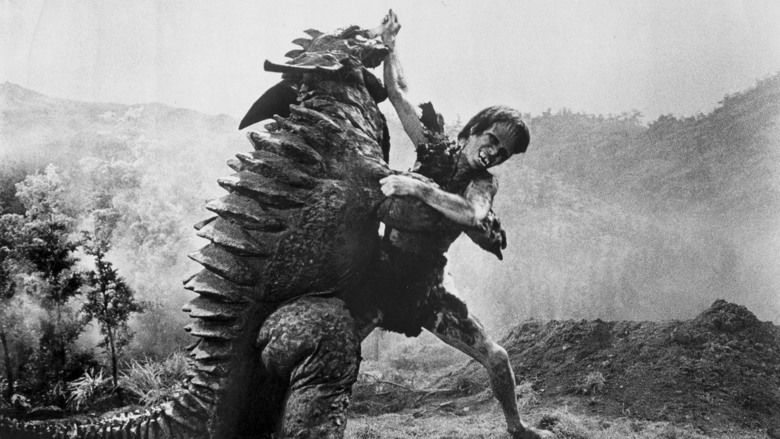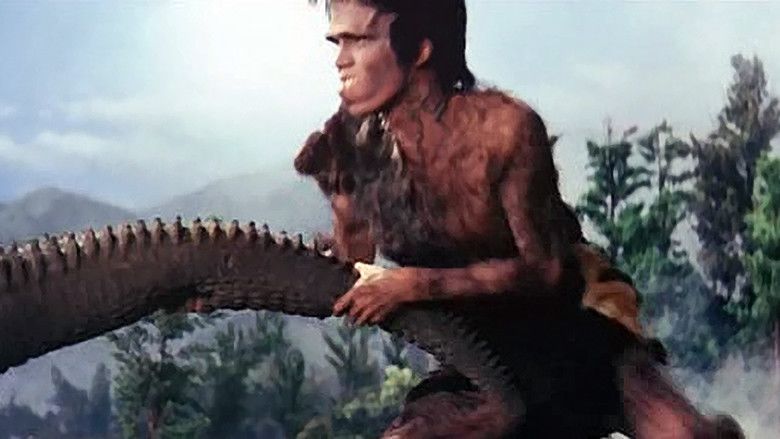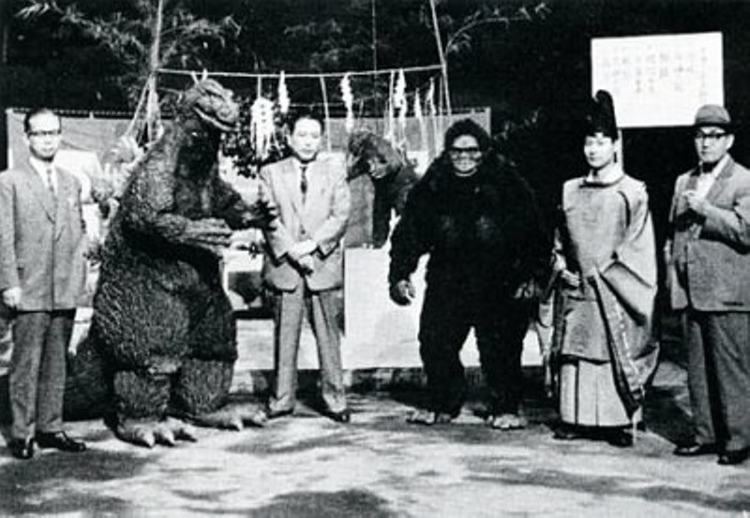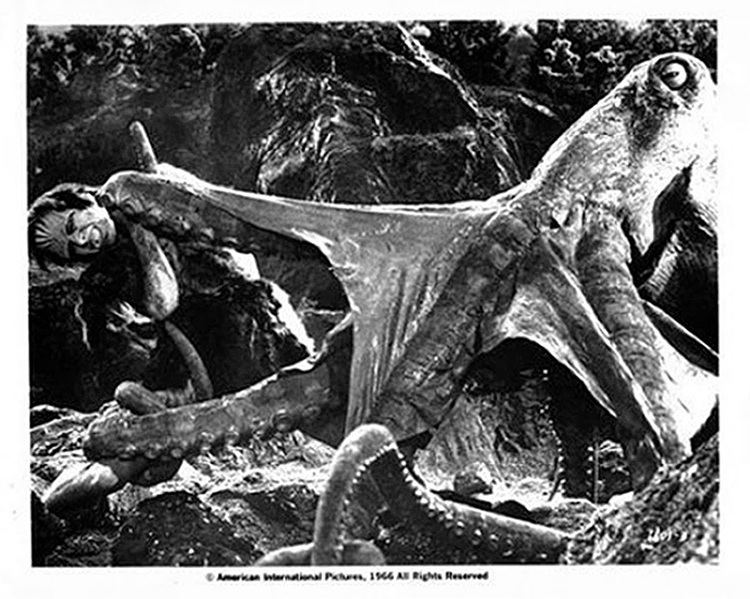Frankenstein Conquers the World
5.2 /10 1 Votes
5.7/10 Letterboxd Genre Horror, Sci-Fi | 4.7/10 IMDb Director Ishiro Honda Duration Country United StatesJapan | |||||||||||||||||||||||||||||||||
 | ||||||||||||||||||||||||||||||||||
Release date August 8, 1965 (Japan)July 8, 1966 (USA) Cast (Dr. Yuzo Kawaji), Nick Adams (Dr. Bowen), (Dr. Togami), (Mr. Kawai), Jun Tazaki (Militäradviso), (Polizeichef)Similar movies Invasion of Astro-Monster , Godzilla: Final Wars , Ghidrah, the Three-Headed Monster , Mothra vs. Godzilla , Godzilla , The Return of Godzilla | ||||||||||||||||||||||||||||||||||
A U.S. scientist (Nick Adams) tries to save postwar Japan from a boy monster, who fights the giant lizard Baragon.
Contents

Frankenstein Conquers the World (released in Japan as Frankenstein versus Subterranean Monster Baragon (, Furankenshutain Tai Chitei Kaiju Baragon)) is a 1965 kaiju film. A Japanese/American co-production, produced by Toho from Japan and Henry G. Sapersteins company UPA from America. Directed by Ishiro Honda and featuring special effects by Eiji Tsuburaya, the film starred Hollywood actor Nick Adams, alongside Japanese actors Tadao Takashima and Kumi Mizuno.

This was the first of two Toho/UPA co-produced films featuring giant-sized Frankenstein monsters. A sequel called War of the Gargantuas was produced the following year.
The film was released theatrically in the United States in the Summer of 1966 by American International Pictures.

During WWII, a human heart taken from Dr. Frankenstein's lab and is kept in Japan where it gets exposed to the radiation of the bombing of Hiroshima. The heart grows in size, mutates and eventually becomes an indestuctable humanoid. Later, a reptilian monster goes on a rampage. Eventually the Frankenstein creature and the reptile face off in a terrible battle.
Plot
The prologue is set in Nazi Germany during the final days of World War II. A Kriegsmarine Officer, flanked by three Commandos, barges into the laboratory of a Dr. Riesendorf with orders to seize the immortal heart of the Frankenstein Monster, on which Riesendorf is busy experimenting. The heart is summarily transported by U-Boat to be passed off to their Japanese allies via the Atlantic. In the Indian Ocean, off the Maldives, the U-Boat meets up with a Japanese Imperial Navy submarine to make the exchange. They are sighted by an Allied Forces scout plane and bombed, but not before the Kriegsmarine pass the heart (contained in a locked chest) to the Japanese, who take it back to Hiroshima for further experimentation. But just as the experiments are about to begin, Hiroshima is bombed by the Allied Forces, and the heart and the experiments vanish in the atomic fireball.

Fifteen years later, in 1960, a feral boy runs rampant in the streets of Hiroshima, catching and devouring small animals such as dogs and rabbits. This comes to the attention of American scientist Dr. James Bowen and his assistants Sueko Togami and Kenichiro Kawaji. A year later (1961), they investigate and find the boy hiding in a cave on a beach, where a mob of outraged villagers has almost caught him. While the strange boy catches media attention and is taken care of by the scientists, another astounding event evades the publics eye. Once the boy is taken to the hospital, it is discovered that he is Caucasian and his body is building a strong resistance to radiation rather than getting sick from it.
The Former Imperial Navy Officer Kawai, who brought the heart of Frankensteins Monster to Japan in WWII, is now working in an oil factory in Akita Prefecture, when a sudden earthquake shakes the very foundations of the refinery and an offshore drilling tower collapses. As the ground splits open, Kawai, for a moment, glimpses a monstrous, inhuman visage peering through the fissure, and an unearthly glow, before it is obscured by collapsing wreckage.
Meanwhile, Dr. Bowen and the scientists find that the strange boy is growing in size due to intake of protein. Afraid of his strength, the scientists lock and chain the boy in a jail cell and Sueko, who really cares for him, feeds him some protein food to sustain him. Meanwhile, Dr. Bowen is visited by Kawai, who tells him that the boy could have grown from the heart of the Frankenstein Monster, as the boy was seen in Hiroshima more than once before. At Bowens advice, Dr. Kawaji confers with the aging Dr. Riesendorf in Frankfurt. Riesendorf tells Kawaji of the story of the Frankenstein Monster and its noted virtual immortality, due to the intake of protein. Riesendorf recommends cutting off the monsters arm or leg, speculating that a new one will grow back. When relating this to his fellow scientists upon his return to Japan, Sueko strongly objects to this method, fearing that nothing may grow back. Even when Bowen suggests that they wait a little longer to think it over, Kawaji tenaciously attempts to sever one of the now-gigantic monsters limbs. He is interrupted by a TV crew, whom Kawaji allows to film the monster, though they enrage it with the shining bright studio lights aimed at its face. The monster, hereafter known as "Frankenstein", breaks loose and goes on the run from the Japanese police. There is a tender encounter between the monster and Sueko on the balcony of her apartment before he has to run away.
While Frankenstein is on the run, he travels to many places, from Okayama (where he eats more animals) to Mount Ibuki, where his primitive childlike activities (throwing trees at birds and trying to trap a wild boar) end in disaster.
Unbeknownst to Bowen and the scientists, Baragon, the monster Kawai saw earlier, goes on a rampage. Tunneling under the earth, he pops out and ravages villages, eating people and animals and leaving destruction in his wake. People believe this is Frankensteins doing, and the misunderstood monster narrowly escapes being hunted down by the military. Before Bowen and his assistants have no choice but to dismiss Frankenstein, Kawai returns to tell them that Frankenstein may not be responsible for the disasters: it could be the monster (Baragon) he saw in Akita. He tries to convince the authorities, but to no avail. Kawaji still wishes the scientists luck in finding Frankenstein.
Bowen, Sueko, and Kawaji then form a search party and venture into the forest in which they believe Frankenstein is hiding. But Kawaji, to the shock of Bowen and Sueko, then proceeds to attempt to kill him, believing that Frankenstein could be dangerous by his very nature, and not even Sueko could possibly tame him. He intends to blind him with chemical grenades and capture him to recover his heart and brain. Kawaji presses on to find Frankenstein, and instead finds Baragon. Kawaji and Bowen try in vain to stop the monster with the grenades, and when it is about to eat Sueko, Frankenstein comes to the rescue. The cataclysmic battle between the two giant monsters then begins. After the fight, the area where the fight took place starts to tremble, and then both monsters are sucked into the earth.
Alternate ending
In the 1960s many stills appeared in the influential genre magazine Famous Monsters of Filmland that showed Frankenstein battling a Giant Octopus (Oodako), that had previously been seen in the film King Kong vs Godzilla. This scene never appeared in any print of the film including the original Japanese version. When this film was in production, trade magazines at the time listed this films title as Frankenstein vs. The Giant Devilfish which led to even more confusion about this mysterious sequence. It wasnt until years later that the story was made available to genre fans via exposure to Japanese publications and an interview with Ishiro Honda the films director. The scene was shot specifically for the American version of the film but was ultimately never used. As Honda explained apologetically: "The movie was made in co-production with an American company, Benedict Pictures Corporation. The bosses were so astonished by the octopus scenes from King Kong vs. Godzilla, they begged to include it into the screenplay, even in spite of logic. So we shot some scenes with the Giant Octopus but, in the end, they were left out of the picture."
The American co-producers were expecting a marine-based battle and ultimately felt the scene wouldnt work and would never use it. When Benedict Pictures would co-produce the films sequel War of the Gargantuas with Toho the following year, an octopus sequence would be shot again (a marine-based battle between the Oodako and Gaira) that would remain intact in both versions of the film.
In the Japanese video edition of Frankenstein Conquers the World, that discarded scene was tagged on as an “alternate ending.” In addition to this scene, American International Pictures (the films U.S Distributor) requested several scenes of a more violent Frankenstein. Unlike the unused ending, these scenes were used in the American version.
Cast
Production
Toho had always been interested in the Frankenstein character, as years earlier producer Tomoyuki Tanaka had originally commissioned a film called Frankenstein vs. the Human Vapor (??????????????? - Furankenshutain tai Gasu Ningen), with a draft written by Kimura. This also follows up with The Human Vapor (1960), as Mizuno finds the Frankenstein Monsters body, and revives him, so that he can help him use the Frankenstein formula to revive his beloved girlfriend Fujichiyo (who died at the end of said film). This was also supposed to be Tohos co-feature with the Japanese release of My Fair Lady.
In 1962, Toho purchased a script from an independent producer from America named John Beck called King Kong vs Prometheus. Beck had stolen the story treatment (which was originally called King Kong vs Frankenstein) from Willis OBrien and had George Worthing Yates flesh it out into a screenplay. Toho wanted to have King Kong fight their own monster Godzilla instead of the Frankenstein giant in the original story and, after working out a deal with Beck as well as RKO, the copyright holder of King Kong at the time, produced King Kong vs Godzilla.
Influenced by the concept of the giant Frankenstein monster from the King Kong vs. Frankenstein/King Kong vs. Prometheus story, Toho planned on making Frankenstein vs. Godzilla as a follow up to King Kong vs. Godzilla. Written in 1963 and planned for a 1964 release, the story dealt with the heart of the original Frankenstein monster becoming irradiated and growing into a Frankenstein-monster giant. Afraid the giant would start eating people, Godzilla would be freed from an icy prison by the JSDF and goaded into a fight with the monster in hopes of killing him. Even though King Kong vs. Godzilla had already been made with Godzilla escaping from an iceberg that he was trapped in at the end of Godzilla Raids Again, script writer Kaoru Mabuchi (a.k.a. Takeshi Kimura) thought with Godzilla disappearing into the ocean at the end of that film, that the idea of Godzilla becoming frozen in the North Sea into another icy prison could still work. The story would end with Godzilla disappearing into a raging river flow, while the Frankenstein giant disappears into magma.
Toho thought the story would not make any sense because the JSDF are trying to get Godzilla (who was still a villain at this point) to kill Frankenstein because they are afraid Frankenstein will start eating humans. So the idea was dropped and Mothra was brought in as Godzillas next opponent for the film Godzilla vs. Mothra (1964).
Toho didnt give up on the original script idea. In 1965, they would finally co produce the story with financial backing from Henry G. Sapersteins film company UPA. A new Dinosaurian opponent named Baragon was created to replace Godzilla and most of the concepts from the original story treatment were retained including the same characters such as Dr.Bowen.
Parallels to the source material
There are many references to the 1931 Frankenstein film adaptation, an iconic representation of the monster featured in the famous book by Mary Shelley. In general, the monster is referred to by the name of his creator ("Frankenstein"), as opposed to "The Frankenstein Monster" (which Dr. Bowen did refer to him as once in this film).
Sequel
The sequel to this film is War of the Gargantuas (titled Furankenshutain no Kaiju: Sanda tai Gaira in Japan). In said film, pieces of Frankensteins cells mutate into two giant humanoid monsters: Sanda (the Brown Gargantua) and Gaira (the Green Gargantua). The former is a benevolent and peace-loving creature, the latter is murderous and savage. Apart from a reference to a severed hand, the US co-producers (United Productions of America), obscured all references to Frankenstein in the American version, possibly because the two monsters could not be recognized as "Frankenstein" monsters. Gaira and Sanda would later appear in two of Tohos Tokusatsu series, Ike! Godman and Ike! Greenman, before remaining absent for over 40 years, with Gaira making his latest appearance in a 2008 Ike! Greenman special as the secondary antagonist.
DVD release
Tokyo Shock
References
Frankenstein Conquers the World WikipediaFrankenstein Conquers the World IMDbFrankenstein Conquers the World LetterboxdFrankenstein Conquers the World themoviedb.org
